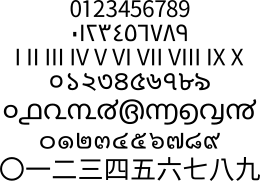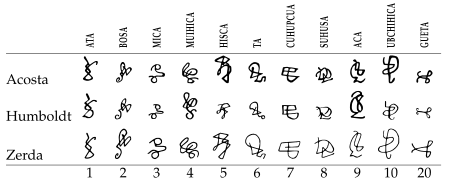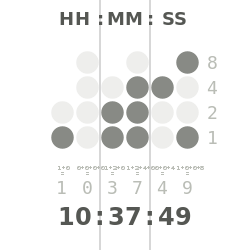List of numeral systems

Arabic, Eastern Arabic, Roman, Bengali–Assamese, Malayalam, Thai, and Chinese numerals
| Numeral systems |
|---|
| Hindu–Arabic numeral system |
| East Asian |
| Alphabetic |
| Former |
| Positional systems by base |
| Non-standard positional numeral systems |
| List of numeral systems |
This is a list of numeral systems, that is, writing systems for expressing numbers.
By culture / time period
| Name | Base | Sample | Approx. first appearance | ||||||||||||||||
|---|---|---|---|---|---|---|---|---|---|---|---|---|---|---|---|---|---|---|---|
| Prehistoric numerals | 35,000 BC | ||||||||||||||||||
| Babylonian numerals | 60 | 3100 BC | |||||||||||||||||
| Egyptian numerals | 10 | or | 3000 BC | ||||||||||||||||
| Aegean numerals | 10 | 𐄇 𐄈 𐄉 𐄊 𐄋 𐄌 𐄍 𐄎 𐄏 𐄐 𐄑 𐄒 𐄓 𐄔 𐄕 𐄖 𐄗 𐄘 𐄙 𐄚 𐄛 𐄜 𐄝 𐄞 𐄟 𐄠 𐄡 𐄢 𐄣 𐄤 𐄥 𐄦 𐄧 𐄨 𐄩 𐄪 𐄫 𐄬 𐄭 𐄮 𐄯 𐄰 𐄱 𐄲 𐄳 | c1500 BC | ||||||||||||||||
| Chinese numerals, Japanese numerals, Korean numerals (Sino-Korean) | 10 | 〇/零 一/壹 二/貳 三/叄 四/䦉 五/伍 六/陸 七/柒 八/捌 九/玖 十/拾 | |||||||||||||||||
| Roman numerals | 10 | Ⅰ Ⅱ Ⅲ Ⅳ Ⅴ Ⅵ Ⅶ Ⅷ Ⅸ Ⅹ L C D M | 1000 BC | ||||||||||||||||
| Hebrew numerals | 10 | א ב ג ד ה ו ז ח ט י כ ל מ נ ס ע פ צ | 800 BC | ||||||||||||||||
| Indian Numerals | 10 | Tamil ௦ ௧ ௨ ௩ ௪ ௫ ௬ ௭ ௮ ௯
Devanagari 0 १ २ ३ ४ ५ ६ ७ ८ ९ |
750 BC – 690 BC | ||||||||||||||||
| Greek numerals | 10 | ō α β γ δ ε ϝ ζ η θ ι ο Αʹ Βʹ Γʹ Δʹ Εʹ Ϛʹ Ζʹ Ηʹ Θʹ | Before 5th century BC | ||||||||||||||||
| Cyrillic numerals | 10 | А҃ В҃ Г҃ Д҃ Е҃ Ѕ҃ З҃ И҃ Ѳ҃ І҃ ... | 10th century | ||||||||||||||||
| Ge'ez numerals | - | ፩, ፪, ፫, ፬, ፭, ፮, ፯, ፰, ፱ ፲, ፳, ፴, ፵, ፶, ፷, ፸, ፹, ፺, ፻ | 3rd-4th century CE, modern style from 15th century CE[1] | ||||||||||||||||
| Chinese rod numerals | 10 | 𝍠 𝍡 𝍢 𝍣 𝍤 𝍥 𝍦 𝍧 𝍨 𝍩 | 1st century | ||||||||||||||||
| Phoenician numerals | 10 | 𐤙 𐤘 𐤗 𐤛𐤛𐤛 𐤛𐤛𐤚 𐤛𐤛𐤖 𐤛𐤛 𐤛𐤚 𐤛𐤖 𐤛 𐤚 𐤖 [2] | Before 250 AD[3] | ||||||||||||||||
| Thai numerals | 10 | ๐ ๑ ๒ ๓ ๔ ๕ ๖ ๗ ๘ ๙ | 7th century[4] | ||||||||||||||||
| Abjad numerals | 10 | غ ظ ض ذ خ ث ت ش ر ق ص ف ع س ن م ل ك ي ط ح ز و هـ د ج ب ا | before 8th century | ||||||||||||||||
| Eastern Arabic numerals | 10 | ٩ ٨ ٧ ٦ ٥ ٤ ٣ ٢ ١ ٠ | 8th century | ||||||||||||||||
| Western Arabic numerals | 10 | 0 1 2 3 4 5 6 7 8 9 | 9th century | ||||||||||||||||
| Burmese numerals | 10 | ၀ ၁ ၂ ၃ ၄ ၅ ၆ ၇ ၈ ၉ | 11th century[5] | ||||||||||||||||
| Maya numerals | 20 | <15th century | |||||||||||||||||
| Muisca numerals | 20 |  | <15th century | ||||||||||||||||
| Aztec numerals | 20 | 16th century | |||||||||||||||||
| John Napier's Location arithmetic | 2 | a b ab c ac bc abc d ad bd abd cd acd bcd abcd | 1617 in Rabdology, a non-positional binary system |
By type of notation
Numeral systems are classified here as to whether they use positional notation (also known as place-value notation), and further categorized by radix or base.
Standard positional numeral systems

A binary clock might use LEDs to express binary values. In this clock, each column of LEDs shows a binary-coded decimal numeral of the traditional sexagesimal time.
The common names are derived somewhat arbitrarily from a mix of Latin and Greek, in some cases including roots from both languages within a single name.[6] There have been some proposals for standardisation.[7]
| Base | Name | Usage |
|---|---|---|
| 2 | Binary | Digital computing |
| 3 | Ternary | Cantor set (all points in [0,1] that can be represented in ternary with no 1s); counting Tasbih in Islam; hand-foot-yard and teaspoon-tablespoon-shot measurement systems; most economical integer base |
| 4 | Quaternary | Data transmission, DNA bases and Hilbert curves; Chumashan languages, and Kharosthi numerals |
| 5 | Quinary | Gumatj, Ateso, Nunggubuyu, Kuurn Kopan Noot, and Saraveca languages; common count grouping e.g. tally marks |
| 6 | Senary | Diceware, Ndom, Kanum, and Proto-Uralic language (suspected) |
| 7 | Septenary | weeks timekeeping |
| 8 | Octal | Charles XII of Sweden, Unix-like permissions, Squawk codes, DEC PDP-11, compact notation for binary numbers, Xiantian (I Ching, China) |
| 9 | Nonary | Base9 encoding |
| 10 | Decimal | Most widely used by modern civilizations[8][9][10] |
| 11 | Undecimal | Jokingly proposed during the French Revolution to settle a dispute between those proposing a shift to duodecimal and those who were content with decimal; check digits in ISBN |
| 12 | Duodecimal | Languages in the Nigerian Middle Belt Janji, Gbiri-Niragu, Piti, and the Nimbia dialect of Gwandara; Chepang language of Nepal, and the Mahl dialect of Maldivian; dozen-gross-great gross counting; 12-hour clock and months timekeeping; years of Chinese zodiac; foot and inch; Roman fractions |
| 13 | Tridecimal | Conway base 13 function |
| 14 | Tetradecimal | Programming for the HP 9100A/B calculator[11] and image processing applications[12]; pound and stone |
| 15 | Pentadecimal | Telephony routing over IP, and the Huli language |
| 16 | Hexadecimal | Base16 encoding; compact notation for binary data; tonal system; ounce and pound |
| 17 | Heptadecimal | Base17 encoding |
| 18 | Octodecimal | Base18 encoding |
| 20 | Vigesimal | Basque, Celtic, Maya, Muisca, Inuit, Yoruba, Tlingit, and Dzongkha numerals; Santali, and Ainu languages |
| 23 | Trivigesimal | Kalam language, Kobon language |
| 24 | Tetravigesimal | 24-hour clock timekeeping; Kaugel language |
| 26 | Hexavigesimal | Base 26 encoding; sometimes used for encryption or ciphering.[13] |
| 27 | Heptavigesimal | Telefol and Oksapmin languages. Mapping the nonzero digits to the alphabet and zero to the space is occasionally used to provide checksums for alphabetic data such as personal names,[14] to provide a concise encoding of alphabetic strings,[15] or as the basis for a form of gematria.[16] |
| 30 | Trigesimal | The Natural Area Code |
| 32 | Duotrigesimal | Base32 encoding and the Ngiti language |
| 33 | Tritrigesimal | Use of letters (except I, O, Q) with digits in vehicle registration plates of Hong Kong |
| 36 | Hexatrigesimal | Base36 encoding; use of letters with digits |
| 40 | Quadragesimal | DEC Radix-50₈ encoding used to compactly represent file names and other symbols on Digital Equipment Corporation computers. The character set is a subset of ASCII consisting of space, upper case letters, the punctuation marks “$”, “.”, and “%”, and the numerals. |
| 52 | Duoquinquagesimal | Base52 encoding, a variant of Base62 without vowels[17] |
| 56 | Hexaquinquagesimal | Base56 encoding, a variant of Base58[18] |
| 57 | Heptaquinquagesimal | Base57 encoding, a variant of Base62 excluding I, O, l, U, and u[19] |
| 58 | Octoquinquagesimal | Base58 encoding |
| 60 | Sexagesimal | Babylonian numerals; NewBase60 encoding, similar to Base62, excluding I, O, and l, but including _(underscore);[20] degrees-minutes-seconds and hours-minutes-seconds measurement systems; Ekari and Sumerian languages |
| 62 | Duosexagesimal | Base62 encoding, using 0–9, A–Z, and a–z |
| 64 | Tetrasexagesimal | Base64 encoding; I Ching in China. This system is conveniently coded into ASCII by using the 26 letters of the Latin alphabet in both upper and lower case (52 total) plus 10 numerals (62 total) and then adding two special characters (for example, YouTube video codes use the hyphen and underscore characters, - and _ to total 64). |
| 85 | Pentoctogesimal | Ascii85 encoding. This is the minimum number of characters needed to encode a 32 bit number into 5 printable characters in a process similar to MIME-64 encoding, since 855 is only slightly bigger than 232. Such method is 6.7% more efficient than MIME-64 which encodes a 24 bit number into 4 printable characters. |
| 91 | Unnonagesimal | Base91 encoding, using all ASCII except "-" (0x2D), "\" (0x5C), and "'" (0x27); one variant uses "\" (0x5C) in place of """ (0x22). |
| 92 | Duononagesimal | Base92 encoding, using all of ASCII except for "`" (0x60) and """ (0x22) due to confusability.[21] |
| 93 | Trinonagesimal | Base93 encoding, using all of ASCII printable characters except for "," (0x27) and "-" (0x3D) as well as the Space character. "," is reserved for delimiter and "-" is reserved for negation.[22] |
| 94 | Tetranonagesimal | Base94 encoding, using all of ASCII printable characters.[23] |
| 95 | Pentanonagesimal | Base95 encoding, a variant of Base94 with the addition of the Space character.[24] |
Non-standard positional numeral systems
Bijective numeration
| Base | Name | Usage |
|---|---|---|
| 1 | Unary (Bijective base-1) | Tally marks |
| 10 | Bijective base-10 | |
| 26 | Bijective base-26 | Spreadsheet column numeration. Also used by John Nash as part of his obsession with numerology and the uncovering of "hidden" messages.[25] |
Signed-digit representation
| Base | Name | Usage |
|---|---|---|
| 2 | Balanced binary (Non-adjacent form) | |
| 3 | Balanced ternary | Ternary computers |
| 5 | Balanced quinary | |
| 9 | Balanced nonary | |
| 10 | Balanced decimal | John Colson Augustin Cauchy |
Negative bases
The common names of the negative base numeral systems are formed using the prefix nega-, giving names such as:
| Base | Name | Usage |
|---|---|---|
| −2 | Negabinary | |
| −3 | Negaternary | |
| −10 | Negadecimal |
Complex bases
| Base | Name | Usage |
|---|---|---|
| 2i | Quater-imaginary base | |
| −1 ± i | Twindragon base | Twindragon fractal shape |
Non-integer bases
| Base | Name | Usage |
|---|---|---|
| φ | Golden ratio base | Early Beta encoder[26] |
| e | Base | Lowest radix economy |
Other
- Mixed radix
- Quote notation
- Redundant binary representation
- Hereditary base-n notation
- Asymmetric numeral systems optimized for non-uniform probability distribution of symbols
Non-positional notation
All known numeral systems developed before the Babylonian numerals are non-positional,[27], as are many developed later, such as the Roman numerals.
See also
- List of numbers in various languages (cardinal number names)
- List of numeral system topics
- Numeral prefix
- Radix
- Radix economy
- Table of bases
References
- ↑ https://books.google.nl/books?id=kXZhBAAAQBAJ&pg=PA148&dq=ethiopic+numerals+coptic&hl=nl&sa=X&redir_esc=y#v=onepage&q=ethiopic&f=false
- ↑ Everson, Michael (2007-07-25). "Proposal to add two numbers for the Phoenician script" (PDF). UTC Document Register. L2/07-206 (WG2 N3284): Unicode Consortium.
- ↑ Cajori, Florian (Sep 1928). A History Of Mathematical Notations Vol I. The Open Court Company. p. 18. Retrieved 5 June 2017.
- ↑ Chrisomalis, Stephen (2010). Numerical Notation: A Comparative History. Cambridge University Press. p. 200. ISBN 9780521878180.
- ↑ "Burmese/Myanmar script and pronunciation". Omniglot. Retrieved 5 June 2017.
- ↑ For the mixed roots of the word "hexadecimal", see Epp, Susanna (2010), Discrete Mathematics with Applications (4th ed.), Cengage Learning, p. 91, ISBN 9781133168669 .
- ↑ http://www.numberbases.com/terms/BaseNames.pdf
- ↑ The History of Arithmetic, Louis Charles Karpinski, 200pp, Rand McNally & Company, 1925.
- ↑ Histoire universelle des chiffres, Georges Ifrah, Robert Laffont, 1994.
- ↑ The Universal History of Numbers: From prehistory to the invention of the computer, Georges Ifrah, ISBN 0-471-39340-1, John Wiley and Sons Inc., New York, 2000. Translated from the French by David Bellos, E.F. Harding, Sophie Wood and Ian Monk
- ↑ HP 9100A/B programming, HP Museum
- ↑ Free Patents Online
- ↑ http://www.dcode.fr/base-26-cipher
- ↑ Grannis, Shaun J.; Overhage, J. Marc; McDonald, Clement J. (2002), "Analysis of identifier performance using a deterministic linkage algorithm", Proceedings. AMIA Symposium: 305–309, PMC 2244404, PMID 12463836 .
- ↑ Stephens, Kenneth Rod (1996), Visual Basic Algorithms: A Developer's Sourcebook of Ready-to-run Code, Wiley, p. 215, ISBN 9780471134183 .
- ↑ Sallows, Lee (1993), "Base 27: the key to a new gematria", Word Ways, 26 (2): 67–77 .
- ↑ "Base52". Retrieved 2016-01-03.
- ↑ "Base56". Retrieved 2016-01-03.
- ↑ "Base57". Retrieved 2016-01-03.
- ↑ "NewBase60". Retrieved 2016-01-03.
- ↑ "Base92". Retrieved 2016-01-03.
- ↑ "Base93". Retrieved 2017-02-13.
- ↑ "Base94". Retrieved 2016-01-03.
- ↑ "base95 Numeric System". Retrieved 2016-01-03.
- ↑ Nasar, Sylvia (2001). A Beautiful Mind. Simon and Schuster. pp. 333–6. ISBN 0-7432-2457-4.
- ↑ Ward, Rachel (2008), "On Robustness Properties of Beta Encoders and Golden Ratio Encoders", IEEE Transactions on Information Theory, 54 (9): 4324&ndash, 4334, arXiv:0806.1083, doi:10.1109/TIT.2008.928235
- ↑ Chrisomalis calls the Babylonian system "the first positional system ever" in Chrisomalis, Stephen (2010), Numerical Notation: A Comparative History, Cambridge University Press, p. 254, ISBN 9781139485333 .
This article is issued from
Wikipedia.
The text is licensed under Creative Commons - Attribution - Sharealike.
Additional terms may apply for the media files.